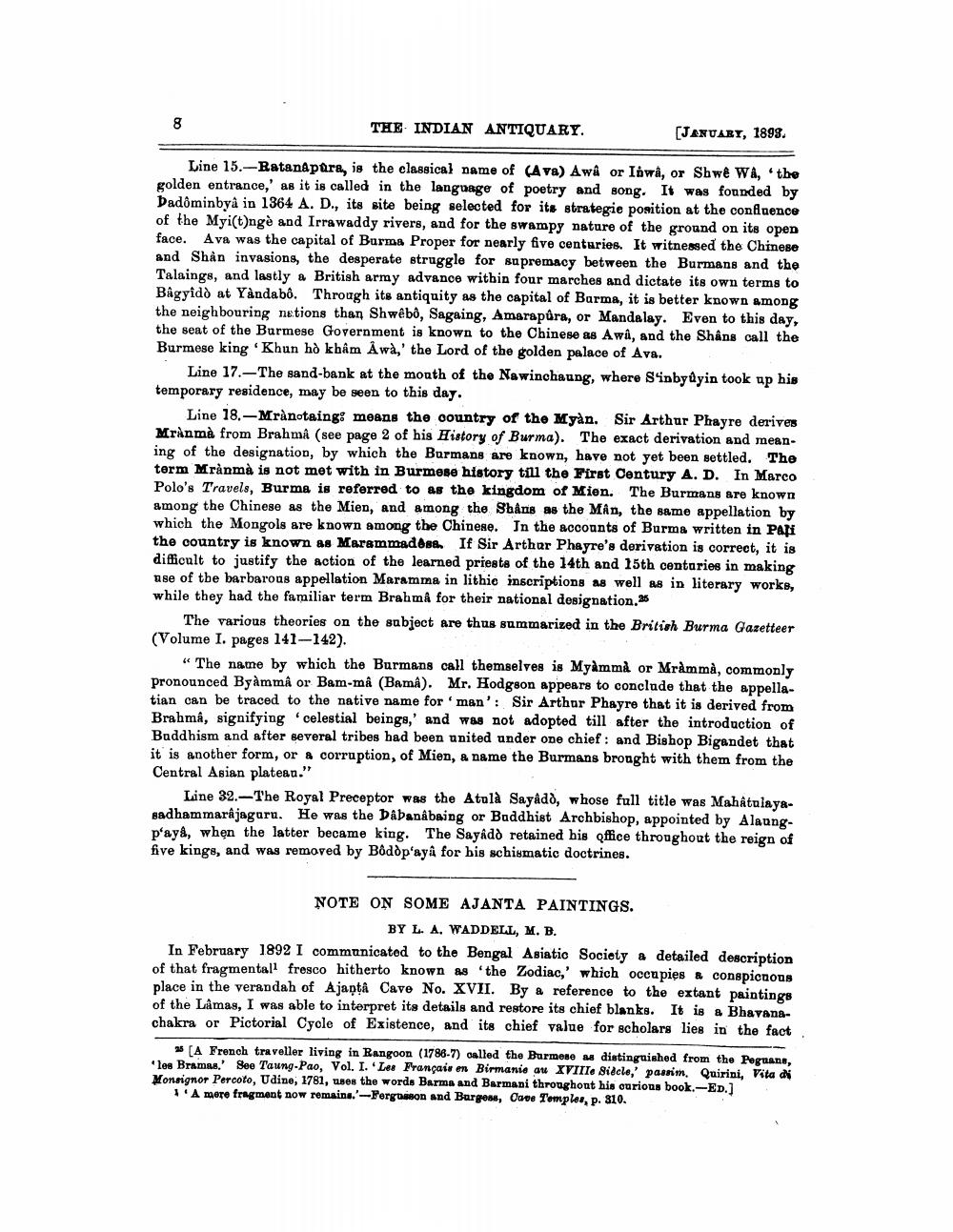________________
8
THE INDIAN ANTIQUARY.
[JANUARY, 1893.
Line 15.-Ratanapura, is the classical name of (Ava) Awâ or Inwa, or Shwê Wa, 'the golden entrance,' as it is called in the language of poetry and song. It was founded by Dadôminbyâ in 1364 A. D., its site being selected for its strategie position at the confluence of the Myi(t)ngè and Irrawaddy rivers, and for the swampy nature of the ground on its open face. Ava was the capital of Burma Proper for nearly five centuries. It witnessed the Chinese and Shan invasions, the desperate struggle for supremacy between the Burmans and the Talaings, and lastly a British army advance within four marches and dictate its own terms to Bâgyidò at Yandabô. Through its antiquity as the capital of Burma, it is better known among the neighbouring nations than Shwêbo, Sagaing, Amarapura, or Mandalay. Even to this day, the seat of the Burmese Government is known to the Chinese as Awâ, and the Shâns call the Burmese king Khun hò khâm Awà,' the Lord of the golden palace of Ava.
Line 17.-The sand-bank at the mouth of the Nawinchaung, where Sinbyûyin took up his temporary residence, may be seen to this day.
Line 18.-Mrànotaing: means the country of the Myàn. Sir Arthur Phayre derives Mrànmà from Brahmâ (see page 2 of his History of Burma). The exact derivation and meaning of the designation, by which the Burmans are known, have not yet been settled. The term Mrànmà is not met with in Burmese history till the First Century A. D. In Marco Polo's Travels, Burma is referred to as the kingdom of Mien. The Burmans are known among the Chinese as the Mien, and among the Shâns as the Mân, the same appellation by which the Mongols are known among the Chinese. In the accounts of Burma written in Pali the country is known as Marammadése. If Sir Arthur Phayre's derivation is correct, it is difficult to justify the action of the learned priests of the 14th and 15th centuries in making use of the barbarous appellation Maramma in lithic inscriptions as well as in literary works, while they had the familiar term Brahmâ for their national designation.25
The various theories on the subject are thus summarized in the British Burma Gazetteer (Volume I. pages 141-142).
"The name by which the Burmans call themselves is Myàmmà or Mràmmà, commonly pronounced Byàmmâ or Bam-mâ (Bamâ). Mr. Hodgson appears to conclude that the appellatian can be traced to the native name for 'man': Sir Arthur Phayre that it is derived from Brahmâ, signifying celestial beings,' and was not adopted till after the introduction of Buddhism and after several tribes had been united under one chief: and Bishop Bigandet that it is another form, or a corruption, of Mien, a name the Burmans brought with them from the Central Asian platean."
Line 32.-The Royal Preceptor was the Atalà Sayâdò, whose full title was Mahâtulayasadhammarajaguru. He was the Dâbanabaing or Buddhist Archbishop, appointed by Alaungpaya, when the latter became king. The Sayâdò retained his office throughout the reign of five kings, and was removed by Bôdòp'ayâ for his schismatic doctrines.
NOTE ON SOME AJANTA PAINTINGS.
BY L. A. WADDELL, M. B.
In February 1892 I communicated to the Bengal Asiatic Society a detailed description of that fragmentall fresco hitherto known as 'the Zodiac,' which occupies a conspicuous place in the verandah of Ajanta Cave No. XVII. By a reference to the extant paintings of the Lâmas, I was able to interpret its details and restore its chief blanks. It is a Bhavanachakra or Pictorial Cycle of Existence, and its chief value for scholars lies in the fact
25 [A French traveller living in Rangoon (1786-7) called the Burmese as distinguished from the Peguans, 'les Bramas. See Taung-Pao, Vol. I. Les Français en Birmanie au XVIIIe Siècle,' passim. Quirini, Vita di Monsignor Percoto, Udine, 1781, uses the words Barma and Barmani throughout his curious book.-ED.]
A mere fragment now remains.'-Fergusson and Burgess, Cave Temples, p. 310.




